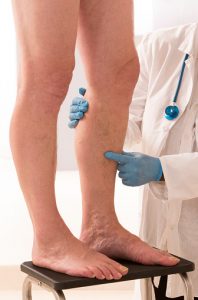 The average person walks about 9,000 steps a day. That’s a total of around 93,000 miles in a lifetime. With a new car, there are no problems for the first 62,000 miles, but eventually, the mileage takes its toll—likewise, as you grow older, the impact of wear-and-tear manifests itself in many different forms on your body, and that includes in the veins. Keeping your veins in peak form as you grow older is a growing need.
The average person walks about 9,000 steps a day. That’s a total of around 93,000 miles in a lifetime. With a new car, there are no problems for the first 62,000 miles, but eventually, the mileage takes its toll—likewise, as you grow older, the impact of wear-and-tear manifests itself in many different forms on your body, and that includes in the veins. Keeping your veins in peak form as you grow older is a growing need.
One of the most common vein problems is varicose veins, which result from pooling of the blood in the veins. Varicose veins look unsightly and can lead to symptoms like tiredness, heaviness, tightness, aches and pains, itching, and restlessness.
Advertisement
The thing is, due to gravity, one cannot prevent varicose veins from forming. However, there are many ways to help prevent them from getting worse and to delay other varicose veins from forming.
The most important thing is to keep your veins well-toned and to keep your calf muscles working at their peak. Here are some simple tips that will help you manage your varicose veins.
Simple tips to manage unhealthy veins
Sitting posture: Avoid sitting for long periods without taking a break and avoid crossing your legs—keep them raised.
Sleeping posture: Putting your feet up for just 10 minutes a day can help. Lie down on a sofa and make sure your feet are raised higher than your heart—or raise the end of your bed by six inches while sleeping. (Natural, cutting-edge formula helps you get a good night’s sleep.)
Weight management: If you’re overweight or obese, try to lose weight. This will ease the pressure on the veins and improve blood flow.
Clothing: Avoid wearing tight clothes, especially those that are tight around your waist, groin (upper thighs), and legs. Tight clothes can make varicose veins worse.
Footwear: Avoid wearing high heels for long periods. If the heels are more than two inches high, they can throw your body out of alignment. If you must wear high heels, try to counteract this by stretching out your Achilles tendon. Lower heeled shoes can help tone your calf muscles, which is important, as toned muscles help blood move through the veins.
Stockings: Well-fitted compression stockings create gentle pressure up the leg. This pressure keeps blood from pooling in the veins and decreases swelling. Anyone going on a flight for more than eight hours should use elastic compression stockings.
Diet: It’s important to eat foods that increase the tone in your muscles. If your daily diet does not consist of fruits and vegetables, you will need to supplement it with vitamins that help tone your veins. A good multivitamin will help.
Exercise: The simplest exercise is walking, as it helps tone the muscles in the leg, reduce body fat, and improve circulation. But it’s important that you walk correctly. While walking, avoid looking down. Keep your head up and look forward. Try to transfer your weight smoothly from one leg to the next. (Natural muscle building secret stuns modern doctor.)
Another simple exercise is stretching. Try these simple stretches every day after a warm bath or shower.
Advertisement
Stand facing up the stairs, holding the handrails, and using your forefeet and toes to stand on a step. Drop the back of your feet off, letting your heels dip down towards the step below. You should feel a deep stretch in the back of the calves and Achilles tendon.
As you can see, keeping those veins and legs healthy is just a matter of a little discipline, mindfulness about postures, and simple exercise routines. Try and do them regularly so that they turn into a habit.
Related: Eliminate Your Varicose Veins (In Time For Summer!) with these 5 Natural Remedies
